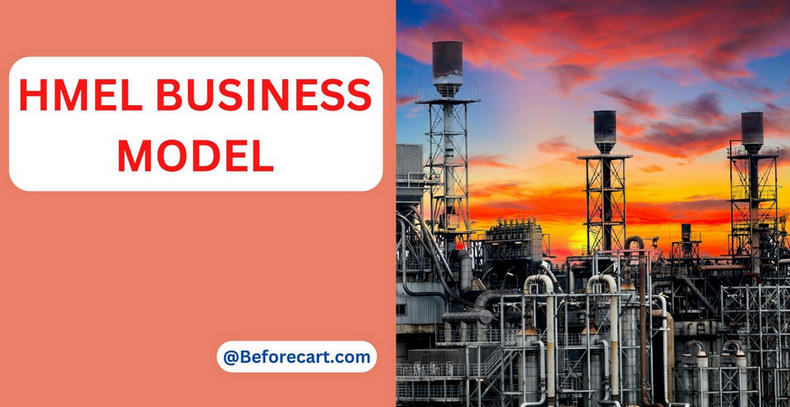We are back with another fresh article on an oil and gas refinery company. The purpose of this article is to provide you with information about the HMEL Business Model. Let’s start with its abbreviation.
What is the Full Form of HMEL?
Table of Contents
The Full Form of HMEL is HPCL-Mittal Energy Limited. HMEL is a joint venture between Hindustan Petroleum Corporation Limited (HPCL) and Mittal Energy Limited. HMEL is also known as Hindustan Mittal Energy Limited.
Recommended: What is the Full Form of BHEL? Complete information about BHEL Share Price Target.
What is HMEL?
HMEL is an Oil and Gas refinery company started in 2007. The company is a joint venture between HPCL and Mittal Energy Limited Singapore. It was built in a record four years. It goes by the name of Guru Govind Singh refinery, and it is based in Bhatinda.
You may also check the Spacecraft launching and manufacturing company, SpaceX, and its business model.
Who is the Owner of HMEL?
The owner of HMEL is Lakshmi N. Mittal and her family. Mittal group entered the refinery sector in 2005 by forming a joint venture with one of the top Oil and Gas refinery companies in India, ONGC (Oil and Natural Gas Corporation).
What are the different products of HMEL?
HMEL produces Petrol, Diesel, Kerosine, Aviation Turbine Fuel (ATF), Naphtha, Pet Coke, and some petrochemicals. Recently, they also added some Bitumen plants.
History Behind The HMEL Business model | HMEL Bhatinda | Guru Govind Singh Refinery
India, a nation searching for one of the oldest civilizations on earth, is embracing the dawn of the future. To sustain this growth, India needs a lot of oil and the ability to define it quickly and efficiently. Responding to this challenge, the Guru Gobind Singh refinery was set up in a record time of four years, making it the fastest oil refinery to be built in India.
An industrial superstructure powering lives across the country is in the middle of the agricultural heartland of Punjab. Close to 50 degrees Celsius, almost 9 degrees lower than the highest temperature ever recorded on the planet. The agenda is reeling under a severe heat wave.
This small town in scorching North India barely shows any sign of activity. But inside the Guru Gobind Singh refinery, work cannot stop. Humans and machines sweat it out 24/7. At stake is the health of one of the fastest-growing economies in the world.
This part of the country has a deficit of petroleum products, petrol, diesel, LPG, and kerosene. So this refinery is catering to the consumer’s needs directly and the industries to give employment.

What occupies these 2,000 acres, the size of over 1,100 football fields, is a formidable concrete and steel giant. This mega enterprise has gobbled over 1 lakh 15 thousand metric tons of structural steel, weighing around 15 Eiffel Towers.
This seamlessly active player beams at $1, standing at 140 meters tall, almost twice the height of Qutub Minar.
The maze of pipes crisscrossing this superstructure can cover a staggering distance of over 3,200 kilometres. Approximately the length from the northern to the southern tip of the country now, this steel structure may stand to dominate the landscape and skyline. But to build this giant steel and concrete structure was a momentous task.
In 2007, Hindustan Petroleum Corporation Limited HPCL and Mittal energy investment joined to form Hindustan Mittal Energy Limited and started working under the HMEL Banner.
Their purpose is daring, to turn a barren piece of land into a mega refinery. Usually, a refinery takes anything upwards of five years to complete. But HMEL aims to get this superstructure ready within four.
Recommended: You may read the share price prediction of India’s leading refinery company IOCL.
How building a refinery is so difficult than making houses?
Building a refinery is not as simple as making a house. Highly combustible liquids and gases will run through this complex web of pipes and reactors. Even the slightest of negligence can result in a catastrophe. Attention has to be paid to the minutest details while setting up this colossal structure.
On pipes and vessels were insulated to maintain stable and desired temperatures. And all high-pressure systems and joints were tested for talking and tensioning to ensure leakage.
On 1st July 2010, after 119 days on the road, the reactors reached Bhatinda one day ahead of the scheduled time. In the middle of the lush green fields of Bhatinda stands this superstructure, powering the lives of millions of Indians across the northern part of the country.
In 1996, Bhatinda was selected as the site for constructing this mega refinery to meet the energy shortfall in North India. But there was one major disadvantage; India depends on crude oil imports. Massive ships carrying crude from different parts of the world docked at Indian ports. From here, crude oil is transported to the refineries primarily located nearby. It required nothing short of genius to design a pipeline that would quench the thirst of this mega refinery day in and day out.
To collect crude oil from supertankers, a single point mooring system or SPM was installed ten kilometres offshore Mundra giving massive crude carriers adequate depth to drop anchor and discharge crude oil to SPM, which in turn diverts the oil into an underwater pipeline located 32 meters below the sea level to Chinese lantern shaped pipes carry the natural oil from the SPM to the submerged pipeline.
Their additional length allows the SPM to stay on water even during high tides. After travelling through the underwater pipeline for ten kilometres, the crude oil hits the shore. The pipeline stretches another seven kilometres from the coast to reach the crude oil terminal. Different types of crude from around the world are collected and stored at the crude oil terminal before it is systematically discharged to run the refinery at Bhatinda.
Besides storage, blending is done at the crude oil terminal. Heavy crude oil is blended with lighter crude oil at the airport. This rich crude oil corrodes the insides of the pipeline due to its high sulfur content and has to be blended with crude oil that has low sulfur content. Once the blending is done, the crude is ready for a journey of over a thousand kilometres to Bhatinda.
Covering a staggering 1017 kilometers, engineers built one of the longest underground pipelines in India. It runs across four states to seamlessly supply oil to the refinery but endure. Two heavy pumping stations located at Bandra in Gujarat and Tanza in Rajasthan maintain the pressure and ensure a seamless flow of crude oil in the pipeline as it reaches Bhatinda. But building the underground pipeline had its own set of challenges.
But dealing with labour and weather is one of the many challenges while building a structure of this scale and magnitude.
HMEL Refining Process:
Once the crude oil reaches Pottinger, it is ushered into the crude distillation unit at a minimum of 400 degrees Celsius, the first step of the refining process. Once the boiling point Rises, different vapours escape at different temperatures, which are then chemically treated to make them available as finished products.
The fluidized catalytic cracking unit FCC you is the heart of the oil refinery, and with good reason. It chemically breaks heavy hydrocarbons to produce various valuable products, such as polypropylene.
What are the uses of this Polypropylene?
”This FCC focuses protein is converted into polypropylene through a polypropylene unit. This polypropylene is used for making all these products around you like credit cards, mobile phones, car dashboards, buckets, etc.”
Day in and day out, workers and machines work seamlessly to ensure that the superstructure turns out products on which our world operates. Forged in just over four years, this refinery fuels millions of lives across North India and ensures that the chariot of growth never holds.
Precautions:
While dealing with such volatile substances, one must always be prepared for the worst. The slightest spark or leakage can put lives at risk, even undetected by the normal eye.
Besides, leading to billions of dollars of investment being burnt to ashes. An elaborate safety system ensures no leaks or sparks, so engineers are always on the watch. Any dip in pressure in the pipeline reflects on the monitors. The potential side of the leakage is immediately determined, and a quick response team is dispatched to fix the leak.
During an interview, a higher authority in the company stated,
”We operate a high-risk industry here with that in mind; we must have things in place to protect people and equipment. We have billions of dollars of equipment out there traces people’s lives at risk. We have systems in place where we can react to every situation that workers have. We have alarms coming from the refinery to the main fire station here. That will enable us to respond within three minutes to any location in the refinery. We can deal with any situation that may arise.”
”It is the responsibility of the laboratory to make sure that any drop of oil. If it is moving from the refinery, it must meet the specification, and we ensure that the product is always meeting specifications at every stage of the movement.”
Recommended: SDMS IOCL Login
Besides refining crude oil, what are the other things HMEL do?
Besides refining crude oil, this superstructure stores, packs, and transports its products. These tanks contain diesel and petrol. And soon, they will be systematically dispatched through road, rail, and pipeline to fuel our lives.
A dedicated gage of rail tracks runs through the refinery so cargo trains can come and collect liquid and solid products for dissemination across the country.
Recommended: You may also read the share price prediction of India’s top-class refinery company, ONGC.
What does HMEL do to avoid external power sources?
To keep this refinery running, a 165 mega-watt captive power plant was designed to avoid dependence on external power sources. From refining to packaging to transport, work at this mega refinery carries on seamlessly to meet the demands of over 150 million Indians.
As the Sun sets, the refinery lights up like a metropolis. Like a beam from a lighthouse shining across an empty horizon.
Built-in just four years, The Guru Gobind Singh refinery is the fastest to be constructed in India.
Frequently Asked Questions:
What does HMEL do?
HMEL is an oil and gas refinery company which produces Petrol, Diesel, Kerosine, LPG, Aviation Turbine Fuel (ATF), Pet Coke, Naphtha, Bitumen, and some petrochemicals.
Is HMEL a government company?
HMEL is a joint venture of Hindustan Petroleum Corporation Limited (Govt. of India Enterprise) and Mittal Energy Limited.
Where is Guru Gobind Singh refinery situated?
Guru Govind Singh refinery is situated in a village name Phullokhari. It is two kilometres from Raman Mandi, Bathinda, Punjab, India.
Who is the chairman of HMEL?
Mr Aditya Mittal is the chairman of the joint venture, HMEL.
Final Thoughts:
In this article, you read about the Successful Business Model of HMEL. I hope you enjoyed this article.
Thanks for reading.





